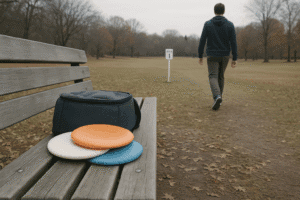If your drives sometimes sing and sometimes shank, you are not broken, you are guessing. Disc golf rewards calm planning far more than raw power. The quickest way to cut strokes is simple, use clear disc golf strategies that turn every throw into a small, smart decision. That takes pressure off your arm, and puts it onto your plan.
Disc Golf Strategies That Actually Save Strokes
Think like a caddie with a backpack of plastic. You want course management, not hero shots. Here is how to make that mindset practical.
Disc golf throw techniques that travel under pressure
Form is your engine. Technique is the map. Train both so they hold up on the last tee, not just the first.
- Backhand and forehand Practice both so you always have a workable line. Aim for throw consistency, not highlight reels.
- Throwing angles Learn hyzer, flat, and anhyzer. Match angle to the ceiling, the skip, and the ground play you want.
- Power and accuracy Add speed slowly. Keep nose angle down, hips leading, and a clean hit. Film reps so skill progression is visible.
- Training drills Field work with gates, 10 upshots to one basket, and a putting ladder. Short, focused sessions beat random heaving.
Disc golf grip techniques and stance tips for balance
Your hands and feet set the shot before the disc moves.
- Grip Pick a power grip for drives and a fan grip for control. Pressure sits in the last two fingers, wrist neutral, index guiding.
- Stance Match stance to the line. Narrow for touch, wide for power. Keep balance and posture centred over the plant foot.
- Footwork Smooth X-step, eyes on the line, plant closed enough to clear the hips. Avoid overstriding, it kills timing.
- Disc golf tips Build a tiny pre-shot routine, breathe out, check aim, commit.
Disc golf disc selection guide
Pick the flight you need, then pick the disc that does it at your power. That is strategic planning in one sentence.
- Stability tiers Overstable for wind and skips. Stable for straight. Understable for turnovers and touch.
- Speed control Lower speed often flies truer. If you keep missing long or turning early, disc down.
- Plastic and wear Beat-in adds glide and turn. Keep two of your favourites at different wear for options.
Wind, Terrain, and the Mental Game
Conditions change lines more than your wrist does. Build habits that read the day, then play the high percentage shot.
Wind tips for disc golf
- Wind reading Watch treetops, flags, and ripples on water, not only your card mate’s hat. Test with a light toss.
- Angle choice Into headwind, throw lower and a tick more stable. With tailwind, add height and glide. Crosswind likes hyzer into the wind and anhyzer away from it.
- Disc choice In gusts, overstable mids beat wobbly drivers. Simpler release, fewer surprises.
Terrain strategy disc golf
- Terrain adaptation On woodsy lines, throw slower, straighter moulds. In open fields, play the skip. On hills, land flat to stop rollaways.
- Landing zones Play to the wide side of trouble. Favour angles that leave a clean next shot.
- Ground play Read grass height and firmness. Skip and slide can add or steal metres.
The mental game in disc golf
- One-shot focus Park the last throw. Name the next task out loud, “Flat mid to the big tree.”
- Pressure routine Same breath, same look, same pace. Rituals reduce noise.
- Risk filter Ask, “If I miss, where am I?” If the answer is double bogey, change the plan.
- Mental toughness Play boring golf on bad days. Pars keep you in it while others donate strokes.
Training That Pays Off
Disc golf fitness exercises
- Core strength exercises Dead bugs, Pallof press, and rotational chops. Strong midsection, cleaner transfer.
- Mobility Hips, thoracic spine, and shoulders. Ten minutes of range buys metres without forcing.
- Balance Single-leg holds and slow plant drills. Stable base, cleaner swing.
Course reconnaissance and planning
- First look Walk the key holes. Note ceilings, slopes, and wind pockets. That is course management in action.
- Play to strengths If your forehand lands softer, plan for it. Your best average beats your fanciest trick.
- Shot library Write two safe lines and one green light line for each signature hole.
Goals, Tracking, and Continuous Learning
Disc golf goal setting
- Set targets One technical, one scoring, one mental. For example, 70 percent circle-one putting, no double bogeys, one breath before each throw.
- Make it visible Post goals on your bag card. Check them at the turn.
Disc golf performance tracking
- Disc golf journal Log wind, discs used, misses left or right, and stress level. Patterns beat hunches.
- Simple stats Fairways hit, circle-one and circle-two putting, scramble rate. Review weekly, adjust drills.
- Continuous learning One clinic, one form cue, one video per month. Small upgrades add up fast.
Keep shots simple, decisions calmer, and practice focused. With smart disc golf strategies and a tidy routine, your scores drop without adding muscle. That is progress you can feel on the card and see on the card.






